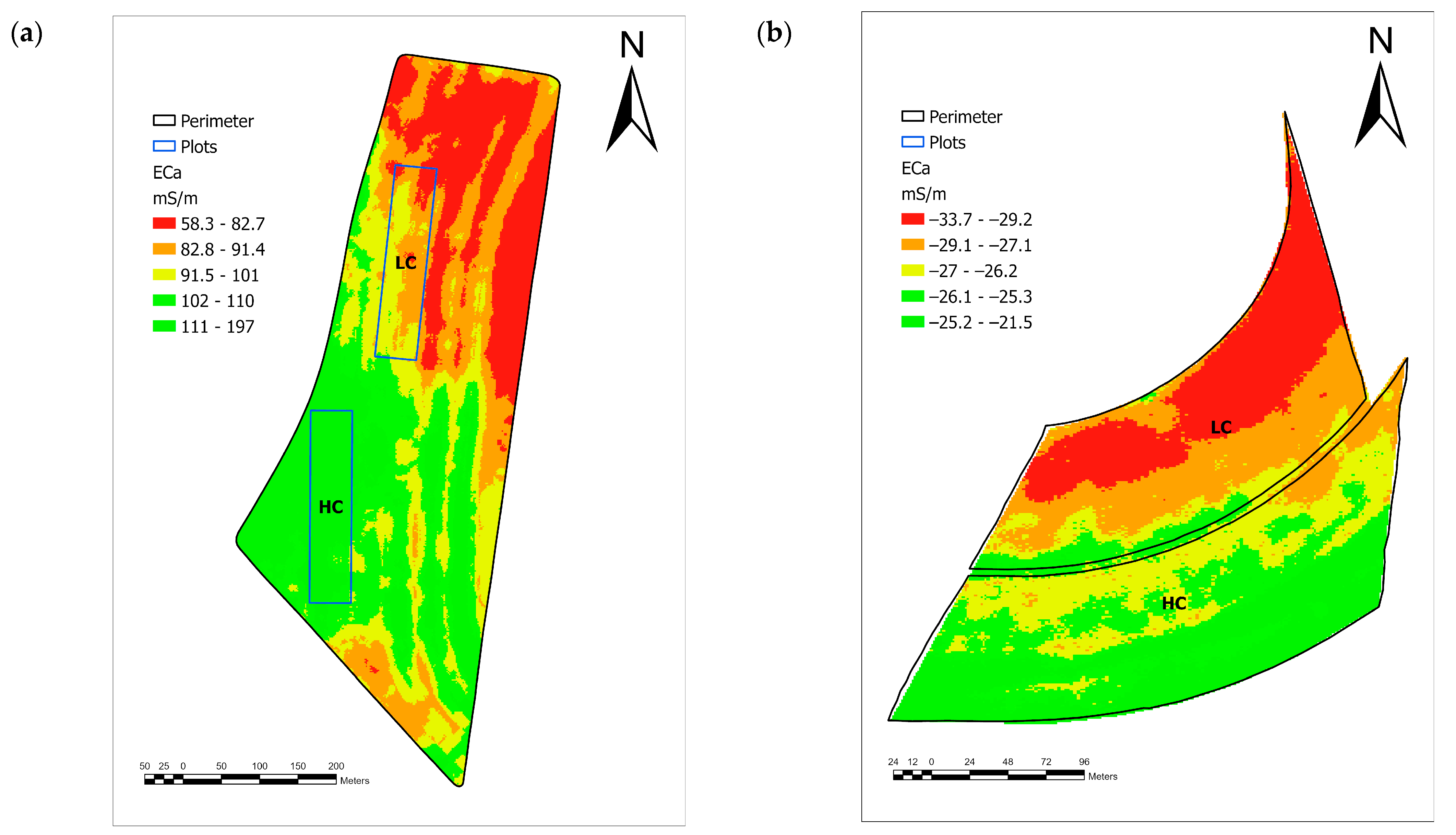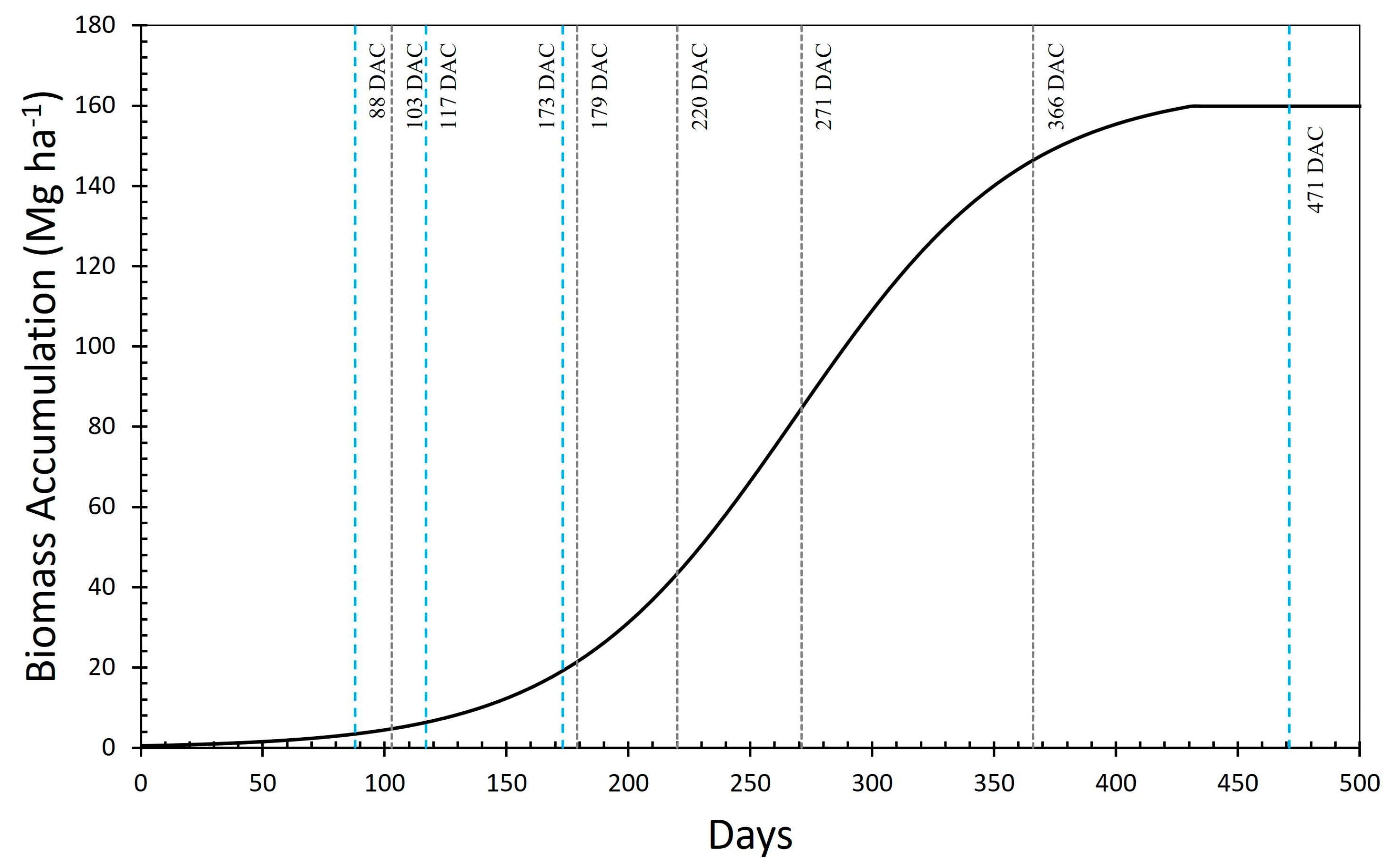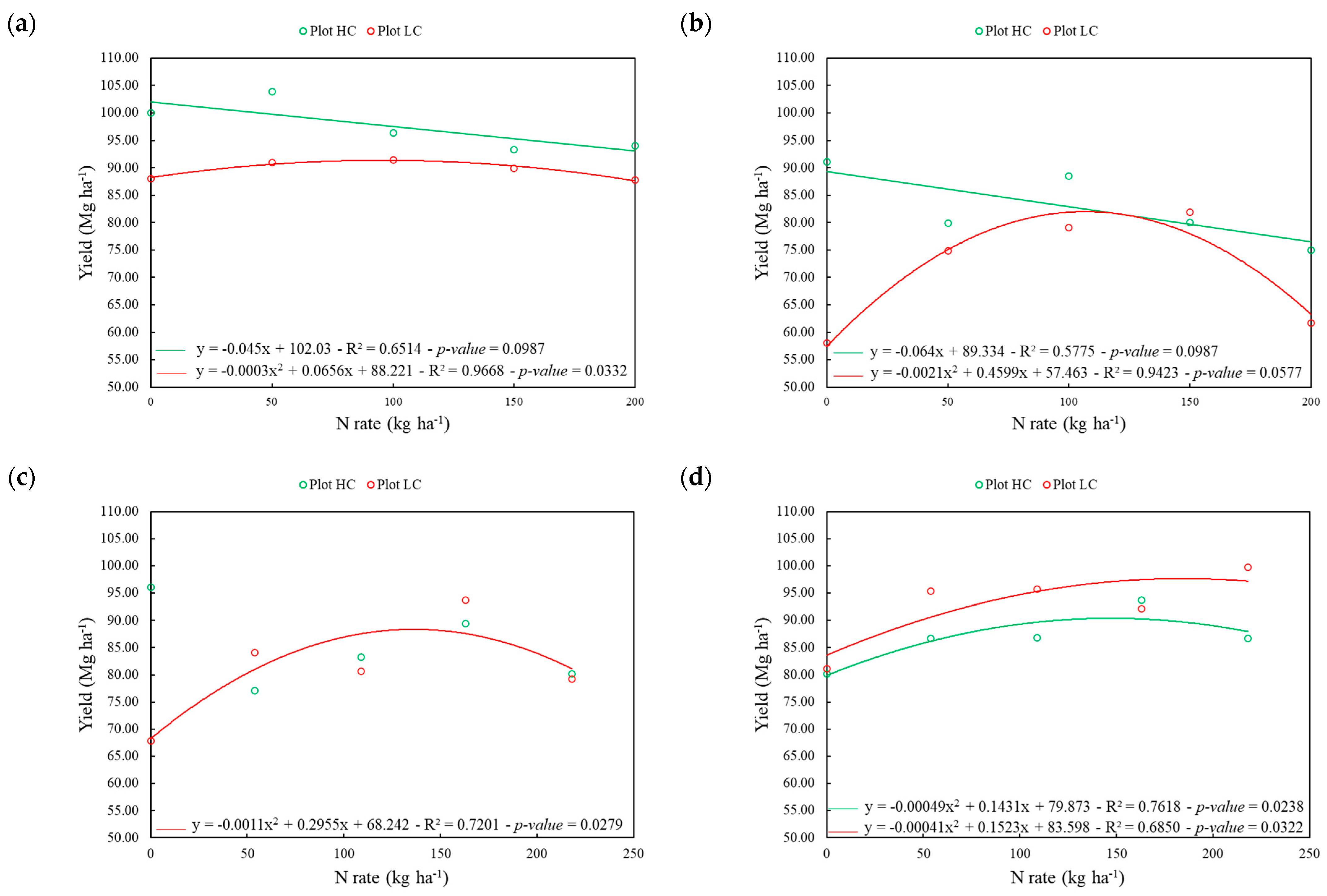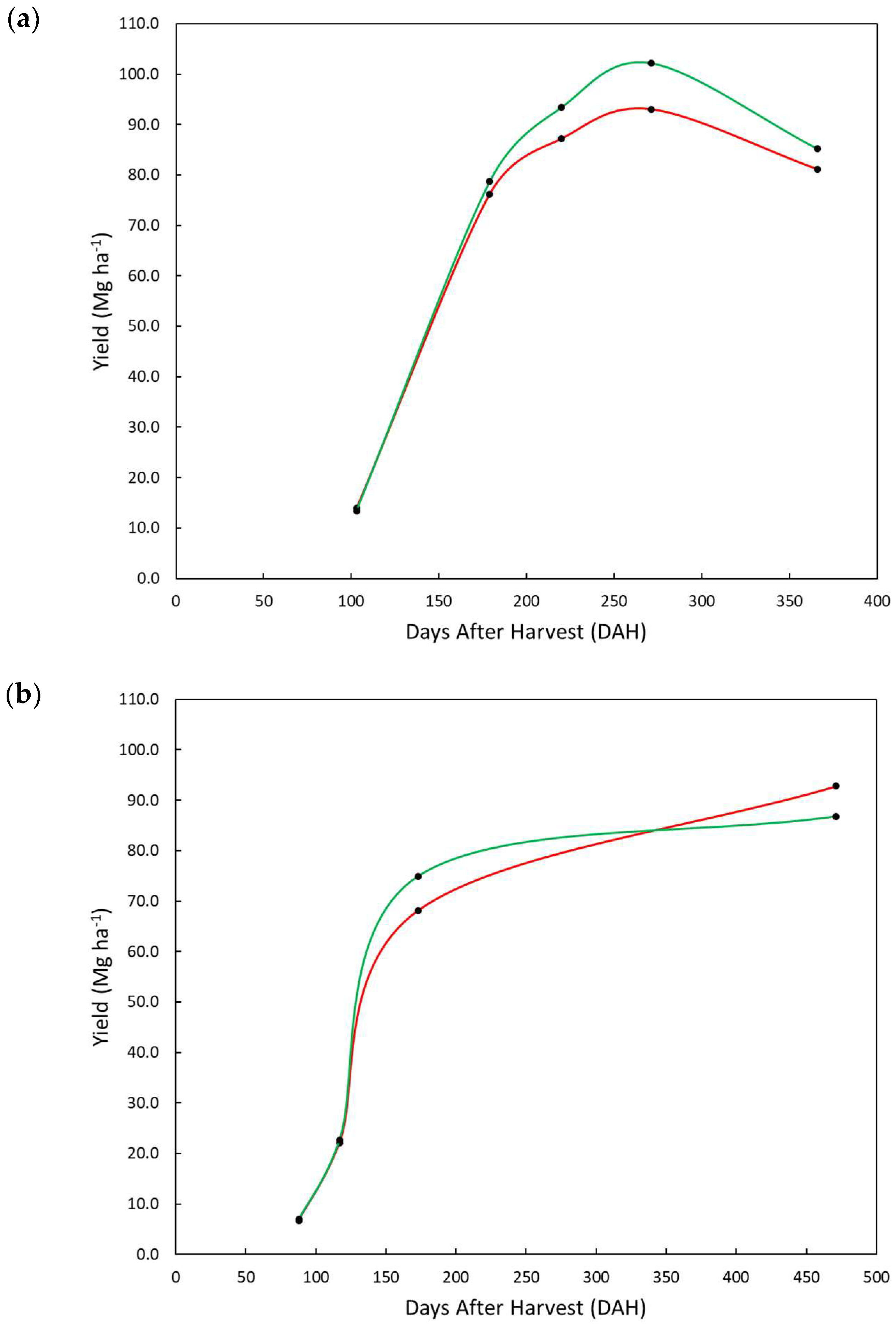Using Soil Apparent Electrical Conductivity (ECa) to Assess Responsiveness of Nitrogen Rates and Yield in Brazilian Sugarcane Fields
Abstract
1. Introduction
2. Materials and Methods
2.1. Study Areas
2.2. Experimental Design
2.2.1. Area 1
2.2.2. Area 2
2.3. Evaluated Parameters
2.3.1. Soil
2.3.2. Crop Yield
Area 1
Area 2
2.4. Data Analyses
3. Results
4. Discussion
Conceptual Framework
5. Conclusions
Author Contributions
Funding
Data Availability Statement
Conflicts of Interest
References
- Companhia Nacional do Abastecimento (CONAB). Acompanhamento da Safra Brasileira; Cana-de-Açúcar, SAFRA 2024/25 Terceiro Levantamento Novembro/2024; CONAB: Brasília, Brazil, 2024; p. 56. [Google Scholar]
- Franco, H.C.J.; Castro, S.G.Q.; Sanches, G.M.; Kölln, O.T.; Bordonal, R.O.; Borges, B.M.M.N.; Borges, C.D. Alternatives to Increase the Sustainability of Sugarcane Production in Brazil under High Intensive Mechanization. In Sustainable Sugarcane Production; Singh, P., Tiwari, A.K., Eds.; Apple Academic Press: Palm Bay, FL, USA, 2018; p. 426. [Google Scholar]
- Mariano, E.; Otto, R.; Montezano, Z.F.; Cantarella, H.; Trivelin, P.C.O. Soil Nitrogen Availability Indices as Predictors of Sugarcane Nitrogen Requirements. Eur. J. Agron. 2017, 89, 25–37. [Google Scholar] [CrossRef]
- Spironello, A.; Van Raij, B.; Penatti, C.P.; Cantarella, H.; Morelli, J.L.M.; Orlando Filho, J.; Landell, M.G.A.; Rossetto, R. Cultara da Cana-de-Açúcar. In Recomendação de Adubação e Calagem para o Estado de São Paulo, 2nd ed.; Van Raij, B., Cantarella, H., Quaggio, J.A., Furlani, A.M.C., Eds.; Instituto Agronômico: Campinas, Brazil, 1997; pp. 237–239. [Google Scholar]
- Cantarella, H.; Rossetto, R. Fertilizers for Sugarcane. In Sugarcane Bioethanol—R&D for Productivity and Sustainability; Cortez, L.A.B., Ed.; Edgard Blücher: São Paulo, Brazil, 2014; pp. 405–422. [Google Scholar]
- Crutzen, P.J.; Mosier, A.R.; Smith, K.A.; Winiwarter, W. N2O Release from Agro-Biofuel Production Negates Global Warming Reduction by Replacing Fossil Fuels. Atmos. Chem. Phys. 2008, 8, 389–395. [Google Scholar] [CrossRef]
- de Vries, F.; Bardgett, R. Plant-Microbial Linkages and Ecosystem N Retention: Lessons for Sustainable Agriculture. Front. Ecol. Environ. 2012, 10, 425–432. [Google Scholar] [CrossRef]
- Soares, J.R.; Cantarella, H.; Vargas, V.P.; Carmo, J.B.; Martins, A.A.; Sousa, R.M.; Andrade, C.A. Enhanced-Efficiency Fertilizers in Nitrous Oxide Emissions from Urea Applied to Sugarcane. J. Environ. Qual. 2015, 44, 423–430. [Google Scholar] [CrossRef]
- Subbarao, G.V.; Ito, O.; Sahrawat, K.L.; Bery, W.L.; Nakahara, K.; Ishikawa, T.; Watanabe, T.; Suenaga, K.; Rondon, M.; Rao, M. Scope and Strategies for Regulation of Nitrification in Agricultural Systems. Plant Sci. 2006, 25, 303–335. [Google Scholar]
- Otto, R.; Castro, S.A.Q.; Mariano, E.; Castro, S.G.Q.; Franco, H.C.J.; Trivelin, P.C.O. Nitrogen Use Efficiency for Sugarcane-Biofuel Production: What is the Next? BioEnergy Res. 2016, 9, 1272–1289. [Google Scholar] [CrossRef]
- Dourado-Neto, N.D.; Powlson, D.; Bakar, R.A.; Bacchi, O.O.S.; Basanta, M.V.; Cong, P.T.; Keerthisinghe, S.; Ismaili, M.; Rahman, S.M.; Reichardt, K.; et al. Multiseason Recoveries of Organic and Inorganic Nitrogen-15 in Tropical Cropping Systems. Soil Sci. Soc. Am. J. 2010, 74, 139–152. [Google Scholar] [CrossRef]
- Franco, H.C.J.; Otto, R.; Faroni, C.E.; Vitti, A.C.; Oliveira, E.C.A.; Trivelin, P.C.O. Nitrogen in Sugarcane Derived from Fertilizer under Brazilian Field Conditions. Field Crops Res. 2011, 121, 29–41. [Google Scholar] [CrossRef]
- Amaral, L.R.; Molin, J.P.; Schepers, J.S. Algorithm for Variable-Rate Nitrogen Application in Sugarcane Based on Active Crop Canopy Sensor. Agron. J. 2015, 107, 1513–1523. [Google Scholar] [CrossRef]
- Sudduth, K.A.; Kitchen, N.R.; Wiebold, W.J.; Batchelor, W.D.; Bollero, G.A.; Bullock, D.G.; Clay, D.E.; Palm, H.L.; Pierce, F.J.; Schuler, R.T.; et al. Relating Apparent Electrical Conductivity to Soil Properties across the Northcentral USA. Comput. Electron. Agric. 2005, 46, 263–283. [Google Scholar] [CrossRef]
- Molin, J.P.; Faulin, G.D.C. Spatial and Temporal Variability of Soil Electrical Conductivity Related to Soil Moisture. Sci. Agric. 2013, 70, 1–5. [Google Scholar] [CrossRef]
- Ekwue, E.; Bartholomew, J. Electrical Conductivity of Some Soils in Trinidad as Affected by Density, Water and Peat Content. Biosyst. Eng. 2011, 108, 95–103. [Google Scholar] [CrossRef]
- Corwin, D.L.; Lesch, S.M. Apparent Soil Electrical Conductivity Measurements in Agriculture. Comput. Electron. Agric. 2005, 46, 11–43. [Google Scholar] [CrossRef]
- McBratney, A.; Whelan, B.M.; Ancev, T.; Bouma, J. Future Directions of Precision Agriculture. Precis. Agric. 2005, 6, 7–23. [Google Scholar] [CrossRef]
- Corwin, D.L.; Lesch, S.M. Application of Soil Electrical Conductivity to Precision Agriculture: Theory, Principles, and Guidelines. Agron. J. 2003, 95, 455–471. [Google Scholar] [CrossRef]
- Raij, B.V.; Andrade, J.C.; Cantarella, H.; Quaggio, J.A. Análise Química para Avaliação da Fertilidade de Solos Tropicais; Instituto Agronômico: Campinas, Brazil, 2001; p. 285. [Google Scholar]
- Killick, M. An Analysis of the Relationship of Apparent Electrical Conductivity to Soil Moisture in Alluvial Recent Soils, Lower North Island, New Zealand. Master’s Thesis, Massey University, Palmerston North, New Zealand, 2013. [Google Scholar]
- Cursi, D.E.; Gazaffi, R.; Hoffmann, H.P.; Brasco, T.L.; Amaral, L.R.; Dourado Neto, D. Novel Tools for Adjusting Spatial Variability in the Early Sugarcane Breeding Stage. Front. Plant Sci. 2021, 12, 749533. [Google Scholar] [CrossRef]
- Sanches, G.M.; Otto, R.; Adamchuk, V.; Magalhães, P.S.G. Spatial Variability of Soil Attributes by an Electromagnetic Induction Sensor: A Framework of Multiple Fields Assessment under Brazilian Soils. Biosyst. Eng. 2022, 216, 229–240. [Google Scholar] [CrossRef]
- Rossel, R.A.V.; Bouma, J. Soil Sensing: A New Paradigm for Agriculture. Agric. Syst. 2016, 148, 71–74. [Google Scholar] [CrossRef]
- Sanches, G.M.; Magalhães, P.S.G.; Remacre, A.Z.; Franco, H.C.J. Potential of Apparent Soil Electrical Conductivity to Describe the Soil pH and Improve Lime Application in a Clayey Soil. Soil Tillage Res. 2018, 175, 217–225. [Google Scholar] [CrossRef]
- Sanches, G.M.; Franco, H.C.J.; Magalhães, P.S.G. Site-Specific Assessment of Spatial and Temporal Variability of Sugarcane Yield Related to Soil Attributes. Geoderma 2019, 334, 90–98. [Google Scholar] [CrossRef]
- Grego, C.R.; Speranza, E.A.; Rodrigues, C.A.G.; Ronquim, C.C.; Luchiari Junior, A.; Sanches, G.M.; Vaz, C.M.P.; Jorge, L.A.C.; Porto, V.H.B. Experimentação on-farm na Agricultura de Precisão. In Estudo de Caso 6—Zonas de Manejo e Adubação em Área de Cultivo de Cana-de-Açúcar na Fazenda Santa Helena, Ibaté, SP.; Pires, J.L.F., Brandão, Z.N., Eds.; Embrapa Trigo: Passo Fundo, Brazil, 2022. [Google Scholar]
- Medeiros, G.O.R.; Giarolla, A.; Sampaio, G.; Marinho, M.A. Diagnosis of the Accelerated Soil Erosion in São Paulo State (Brazil) by the Soil Lifetime Index Methodology. Rev. Bras. Cienc. Solo 2016, 40, e0150498. [Google Scholar] [CrossRef]
- Sanches, G.M.; Otto, R. A Novel Approach for Determining Nitrogen Requirement Based on a New Agronomic Principle—Sugarcane as a Crop Model. Plant Soil 2022, 472, 29–43. [Google Scholar] [CrossRef]
- Rodriguez, D.G.P.; Bullock, D.S.; Boerngen, M.A. The Origins, Implications, and Consequences of Yield-Based Nitrogen Fertilizer Management. Agron. J. 2019, 111, 725–735. [Google Scholar] [CrossRef]
- Morris, T.F.; Murrell, T.S.; Beegle, D.B.; Camberato, J.J.; Ferguson, R.B.; Grove, J.; Ketterings, Q.; Kyveryga, P.M.; Laboski, C.A.M.; McGrath, J.M.; et al. Strengths and Limitations of Nitrogen Rate Recommendations for Corn and Opportunities for Improvement. Agron. J. 2018, 110, 1–37. [Google Scholar] [CrossRef]
- Amaral, L.R.; Molin, J.P. The Effectiveness of Three Vegetation Indices Obtained from a Canopy Sensor in Identifying Sugarcane Response to Nitrogen. Agron. J. 2014, 106, 273. [Google Scholar] [CrossRef]
- Martins, D.S.; Reis, V.M.; Schultz, N.; Alves, B.J.R.; Urquiaga, S.; Pereira, W.; Sousa, J.S.; Boddey, R.B. Soil Nitrogen and Biological N2 Fixation in Sugarcane with Diazotrophic Bacteria. Plant Soil 2020, 454, 155–169. [Google Scholar] [CrossRef]
- Jaynes, D.B. Confidence Bands for Measured Economically Optimal Nitrogen Rates. Precis. Agric. 2011, 12, 196–213. [Google Scholar] [CrossRef]
- Puntel, L.A.; Pagani, A.; Archontoulis, S.V. Development of a Nitrogen Recommendation Tool for Corn Considering Static and Dynamic Variables. Eur. J. Agron. 2019, 105, 189–199. [Google Scholar] [CrossRef]
- Otto, R.; Mulvaney, R.L.; Khan, S.A.; Trivelin, P.C.O. Quantifying Soil Nitrogen Mineralization to Improve Fertilizer Nitrogen Management of Sugarcane. Biol. Fertil. Soils 2013, 49, 893–904. [Google Scholar] [CrossRef]
- Franzluebbers, A.J. Soil Test Biological Activity with the Flush of CO2: III. Corn Yield Responses to Applied Nitrogen. Soil Sci. Soc. Am. J. 2018, 82, 708–721. [Google Scholar] [CrossRef]
- McDaniel, M.D.; Walters, D.T.; Bundy, L.G.; Li, X.; Drijber, R.A.; Sawyer, J.E.; Castellano, M.J.; Laboski, C.A.M.; Scharf, P.C.; Horwath, W.R. Combination of Biological and Chemical Soil Tests Best Predict Maize Nitrogen Response. Agron. J. 2020, 112, 1263–1278. [Google Scholar] [CrossRef]





| Plot | Clay Content | pH | OM | P | K | Ca | Mg | SB | CEC | V% | ECa |
|---|---|---|---|---|---|---|---|---|---|---|---|
| g kg−1 | --mg dm−3-- | ---------------mmol dm−3--------------- | % | mS m−1 | |||||||
| Area 1 (0.00–0.20 m) | (0.00–0.75 m) | ||||||||||
| HC | 610 | 5.7 | 30 | 24 | 2.3 | 71 | 21 | 94.3 | 122.3 | 77 | 35.46 |
| LC | 606 | 5.2 | 25 | 14 | 1.6 | 37 | 10 | 48.6 | 90.6 | 54 | 24.69 |
| Area 1 (0.20–0.40 m) | |||||||||||
| HC | 633 | 5.7 | 27 | 16 | 1.9 | 53 | 16 | 70.9 | 104.9 | 68 | - |
| LC | 605 | 4.5 | 22 | 17 | 1.2 | 18 | 6 | 25.2 | 89.2 | 28 | - |
| Area 2 (0.00–0.20 m) | (0.00–0.75 m) | ||||||||||
| HC | 108 | 5.6 | 5.9 | 22 | 1.1 | 25 | 13 | 38.7 | 56.6 | 68 | −25.58 |
| LC | 143 | 5.8 | 8.5 | 19 | 1.3 | 28 | 11 | 40.5 | 56.2 | 72 | −29.08 |
| Area 2 (0.20–0.40 m) | |||||||||||
| HC | 123 | 5.56 | 11 | 21 | 0.8 | 22 | 11 | 33.6 | 51.8 | 65 | - |
| LC | 160 | 5.72 | 15 | 19 | 1.1 | 25 | 13 | 38.7 | 56.6 | 68 | - |
| Average | Median | Min. | Max. | SD | CV | |
|---|---|---|---|---|---|---|
| Area 1 | ||||||
| 1st ratoon | ||||||
| Plot HC | 97.53 α | 98.06 | 82.78 | 109.44 | 7.30 | 7.49 |
| Plot LC | 89.63 β | 90.07 | 66.25 | 108.33 | 10.75 | 12.00 |
| 2nd ratoon | ||||||
| Plot HC | 82.91 α | 84.86 | 59.72 | 108.33 | 12.16 | 14.66 |
| Plot LC | 71.14 β | 71.67 | 45.83 | 98.33 | 13.63 | 19.16 |
| Area 2 | ||||||
| 1st ratoon | ||||||
| Plot HC | 85.18 α | 83.23 | 77.08 | 96.05 | 7.60 | 8.92 |
| Plot LC | 81.11 α | 80.71 | 67.84 | 93.67 | 9.31 | 11.47 |
| 2nd ratoon | ||||||
| Plot HC | 86.79 β | 86.74 | 80.13 | 93.68 | 4.79 | 5.52 |
| Plot LC | 92.83 α | 95.36 | 81.14 | 99.72 | 7.06 | 7.60 |
| N rate | ECa | Yield (1st Ratoon) | Yield (2nd Ratoon) | |
|---|---|---|---|---|
| Area 1 | ||||
| N rate | - | 0.25 | −0.02 | 0.15 |
| ECa | −0.47 * | - | −0.30 | −0.09 |
| Yield (1st ratoon) | −0.45 * | 0.51 * | - | 0.29 |
| Yield (2nd ratoon) | −0.38 ** | 0.49 * | −0.15 | - |
| Area 2 | ||||
| N rate | - | 0.00 | 0.06 | 0.29 |
| ECa | −0.20 | - | 0.09 | −0.34 |
| Yield (1st ratoon) | −0.08 | 0.43 * | - | −0.11 |
| Yield (2nd ratoon) | 0.14 | 0.28 | 0.15 | - |
| Yield (Mg ha−1) | |||||||||||||
|---|---|---|---|---|---|---|---|---|---|---|---|---|---|
| Area 1 | Area 2 | ||||||||||||
| Plot HC | |||||||||||||
| N rate | 1st ratoon | 2nd ratoon | N rate | 1st ratoon | 2nd ratoon | ||||||||
| 0 | 100.00 | A | a | 91.11 | A | a | 0 | 96.05 | A | a | 80.13 | A | a |
| 50 | 103.89 | A | a | 79.91 | A | b | 54 | 77.08 | B | b | 86.64 | B | a |
| 100 | 96.39 | A | b | 88.52 | A | a | 109 | 83.23 | A | ab | 86.77 | B | a |
| 150 | 93.33 | A | b | 80.00 | A | b | 163 | 89.38 | A | a | 93.68 | A | a |
| 200 | 94.03 | A | b | 75.00 | A | b | 218 | 80.13 | A | b | 86.74 | B | a |
| Average | 97.53 | α | 82.91 | α | Average | 85.18 | α | 86.79 | β | ||||
| Plot LC | |||||||||||||
| 0 | 88.06 | B | a | 58.06 | B | b | 0 | 67.84 | B | b | 81.14 | A | b |
| 50 | 90.94 | B | a | 74.81 | A | ab | 54 | 84.10 | A | ab | 95.36 | A | ab |
| 100 | 91.46 | A | a | 79.13 | B | a | 109 | 80.71 | A | ab | 95.73 | A | ab |
| 150 | 89.90 | A | a | 81.94 | A | a | 163 | 93.67 | A | a | 92.20 | A | b |
| 200 | 87.81 | A | a | 61.76 | B | ab | 218 | 79.26 | A | ab | 99.72 | A | a |
| Average | 89.63 | β | 71.14 | β | Average | 81.11 | α | 92.83 | α | ||||
Disclaimer/Publisher’s Note: The statements, opinions and data contained in all publications are solely those of the individual author(s) and contributor(s) and not of MDPI and/or the editor(s). MDPI and/or the editor(s) disclaim responsibility for any injury to people or property resulting from any ideas, methods, instructions or products referred to in the content. |
© 2025 by the authors. Licensee MDPI, Basel, Switzerland. This article is an open access article distributed under the terms and conditions of the Creative Commons Attribution (CC BY) license (https://creativecommons.org/licenses/by/4.0/).
Share and Cite
Sanches, G.M.; Faria, H.M.; Otto, R.; Neto, A.S.; Corá, J.E. Using Soil Apparent Electrical Conductivity (ECa) to Assess Responsiveness of Nitrogen Rates and Yield in Brazilian Sugarcane Fields. Agronomy 2025, 15, 606. https://doi.org/10.3390/agronomy15030606
Sanches GM, Faria HM, Otto R, Neto AS, Corá JE. Using Soil Apparent Electrical Conductivity (ECa) to Assess Responsiveness of Nitrogen Rates and Yield in Brazilian Sugarcane Fields. Agronomy. 2025; 15(3):606. https://doi.org/10.3390/agronomy15030606
Chicago/Turabian StyleSanches, Guilherme Martineli, Hugo Miranda Faria, Rafael Otto, Almir Salvador Neto, and José Eduardo Corá. 2025. "Using Soil Apparent Electrical Conductivity (ECa) to Assess Responsiveness of Nitrogen Rates and Yield in Brazilian Sugarcane Fields" Agronomy 15, no. 3: 606. https://doi.org/10.3390/agronomy15030606
APA StyleSanches, G. M., Faria, H. M., Otto, R., Neto, A. S., & Corá, J. E. (2025). Using Soil Apparent Electrical Conductivity (ECa) to Assess Responsiveness of Nitrogen Rates and Yield in Brazilian Sugarcane Fields. Agronomy, 15(3), 606. https://doi.org/10.3390/agronomy15030606







